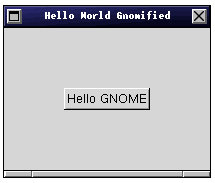Whole document tree
Chapter 3. GNOME Developer's Tutorial.
From the gnome-hello manual:
gnome-hello is a GNOME application which contains all the essential and common features of GNOME programs, such as initialization, event loops, configuration file parsing, internationalization and so forth.
gnome-hello is intended to be an example of the GNOME coding standards, as well as a fun and useless little program.
In this chapter we're going to use it to explain the basics features that an application must have to be considered gnome-compliant.
3.1. Starting with GNOME

We'll start with a very basic application. It's only a window with a button which when clicked, close the window and prints "Hello GNOME". The code source for it is in programs/gnome-hello/gnome-hello-0-basic.c. [FIXME: Should i include the full code here?]
#include <config.h> #include <gnome.h>
All the programs have to include gnome.h which gives all you need to use the Gtk+ and GNOME libraries.
int
main(int argc, char *argv[])
{
gnome_init is always called at the beginning of a program. It takes care of initializing both Gtk and GNOME.
gnome_init (&argc, &argv);
Then we call prepare_app that do the real work and gtk_main to enter into the main processing loop.
prepare_app (); gtk_main (); return 0; }
Let's now go to the prepare_app code...
void
prepare_app()
{
GtkWidget *button;
We first make the main window calling gnome_app_new and connect the signal delete_event to the callback quit_cb, so the user can close the app via the window manager:
app = gnome_app_new ("hello", "Hello World Gnomified");
gtk_widget_realize (app);
gtk_signal_connect (GTK_OBJECT (app), "delete_event",
GTK_SIGNAL_FUNC (quit_cb), NULL);
Then, we create a button and set it to be the content of the main window.
button = gtk_button_new_with_label ("Hello GNOME");
gtk_signal_connect (GTK_OBJECT (button), "clicked",
GTK_SIGNAL_FUNC (hello_cb), NULL);
gtk_container_border_width (GTK_CONTAINER (button), 60);
gnome_app_set_contents ( GNOME_APP (app), button);
Finally, we show the widgets. It could be done in any order, but we display at last the main window so the whole window will pop up at once rather than seeing the window pop up, and then the button form inside of it.
gtk_widget_show (button); gtk_widget_show (app); }
The callbacks (hello_cb for the button and quit_cb for delete_event) are very simple. They just call gtk_main_quit to exit.
void
hello_cb (GtkWidget *widget, void *data)
{
g_print ("Hello GNOME\n");
gtk_main_quit ();
return;
}
void
quit_cb (GtkWidget *widget, void *data)
{
gtk_main_quit ();
return;
}
